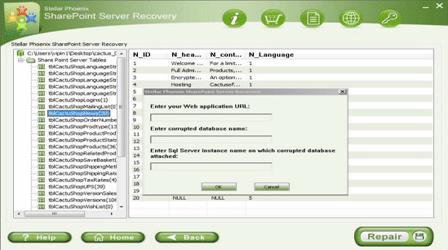Recover Document From The Sharepoint Recycle Bin
Published by Jacob Martin on April 16, 2015
Have you ever notified that the most important document that keeps your company running is now missing and may very likely have been deleted? The same problem can also occur with your SharePoint documents.
MS SharePoint Server is an excellent enterprise-level information portal that gives you a secure and simple means to assign data access permissions to limited users on a wide network. Its MDF databases containing all files, folders and documents that may get corrupted or damaged due to a number of unseen reasons. What you will do if this gets happen with your SharePoint documents?
Here in this blog the main discussion is about the options with which you can restore your corrupted or deleted SharePoint document.
If you are new user to SharePoint administration or forgot about this built-in feature that SharePoint has a Recycle Bin. The Recycle Bin feature can easily save you a lot of time and effort by just a click of a button. Remember, SharePoint’s default settings will save your deleted items only for 30 days, but you can also make adjustment to it.
Recover Document or Backup/Restore SharePoint Recycle Bin
To access the SharePoint Recycle Bin:
- Firstly Log in to the SharePoint site
- Then go to the Site Actions >> Site Settings
- From the group “Site Collection Administration” select Recycle Bin
- Here you will get list of all the items that have been deleted within the last 30 days
- If you won’t get your deleted document, then check the second layer of the SharePoint Recycle bin: “Deleted from end user Recycle Bin”
- Hopefully, this recovers your deleted item.
Configuring SharePoint Recycle Bin Settings at Web Application Level
This will affects the whole site that is hosted by the Web Application. To do adjustment in Recycle Bin settings at the Web application level:
- On the Quick Launch, Click Application Management
- Under Web Applications >> Manage Web Applications
- Select the Web Application to which you want to make adjustment in the Recycle Bin settings. On the SharePoint Ribbon select General Settings >> General Settings
- From the Web Application General Settings navigate to the Recycle Bin section and follow the guidelines below the image to configure to your liking.
Second State Recycle Bin:
- To increase a site’s quota for Recycle Bin items select Add, and then enter the number that is the percentage that you want to extend with. Or else you can select Off to disable second-stage Recycle Bins
- To disable the second-stage recycle bin turn off the second-stage recycle bin.
- Remember your first stage of the recycle bin counts towards your site collection quota but Second stage of recycle bin has its own quota defined by these settings.
- The important and potentially scary nature of 2nd stage recycle bin. If site quota is not configured at the site collection level then recycle bin quota is unlimited.
 |
 |
 |
If still you are enable to retrieve back your deleted or corrupted SharePoint database then you will need to use SharePoint Server Repair Tool as it effectively scans the damaged database files and repairs it to recover inaccessible objects in MDF database files. It also allows the user to retrieve share point database like tables, indexes, documents, labels and stored procedures from inaccessible MDF files. It restores corrupt or deleted database and save the recovered MDF files at specific location on the system.
how to Recover Document From The Sharepoint Recycle Bin
- Firstly launch the SharePoint Recovery Tool you would find an interface. This interface screen displays two options to recover SharePoint data: ‘Complete Repair’ and ‘Document Recovery’ Select as per your requirement.
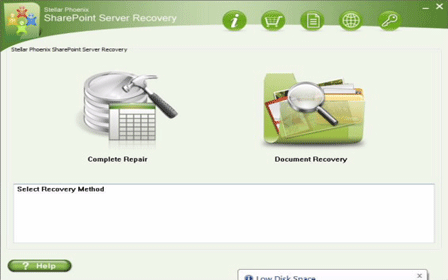
- If you choose ‘Complete Repair’, the screen will show the options for selecting and searching SQL Server (.MDF) files. Click on ‘Select File’ to select a SharePoint database for repair. If you do not know the actual path of the database which you want to repair, click on the ‘Search File’ to locate the MDF file in a specific drive. After selecting the desired file initiate the scanning process
- After finishing the scan, the software would generate a tree of all SharePoint database tables and will display it in the left pane. You can select the table in the tree and can have the entire preview in the right pane. Then Click on ‘Repair’ to begin repairing for the selected database.
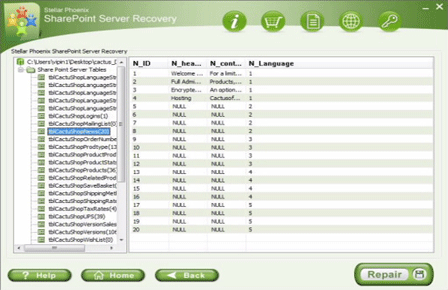
- After clicking on ‘Repair’, this dialog box will appear. Specify the SQL Server name or Instance name and the desired destination path. Click on the ‘Browse’ option to choose the destination path. And select ‘OK’ button.
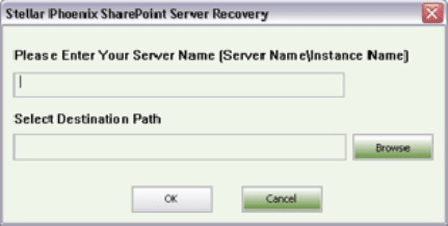
- Once this process gets completed, you would find a dialog box that displays this message ‘Recovered file saved at the desired location. This shows that Recovery Process has successfully completed’. And select ‘OK’ button.
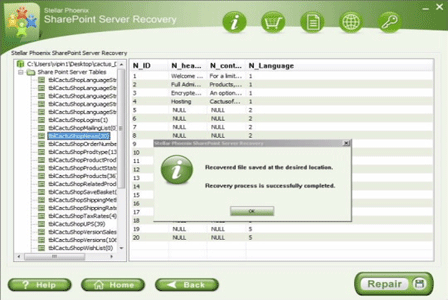
- You would find another dialog box that asks whether you want to attach the repaired database to the web application. If you click on ‘Yes’ button, the above dialog box will be displayed. In the web application URL type, the name of the corrupt database and SQL Server Instance name. Then Select ‘OK’ button and proceed. When the process gets finished, you would be able to access the repaired database by opening the web application.
